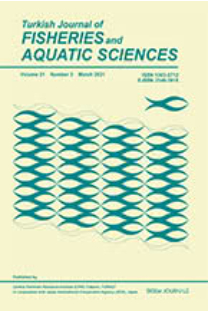Study of Parameters of Biological Rhythms of Plankton Communities in Natural Conditions
___
Akimoto, H., Wu, C., Kinumi, T. and Ohmiya, Y. 2004. Biological rhythmicity in expressed proteins of the marine dinoflagellate Lingulodinium polyedrum demonstrated by chronological proteomics. Biochem. Biophys. Res. Commun., 315: 306-312.Bat, L., Sezgin, M., Satilmis, H. H., Sahin, F., Ustun, F., BirinciOzdemir, Z. and GokkurtBaki, O. 2011.Biological Diversity of the Turkish Black Sea Coast. Turkish Journal of Fisheries and Aquatic Sciences, (11): 683-692.
Cherepanov, O.A., Levin, L.A. and Utyushev, R.N. 2007. Contact bioluminescence with biomass and number of luminous and total plankton. Barents Sea and Norwegian Sea. Mor. Ecol. Zh., 6(1): 55-65. (in Russion)
Gitelzon, I.I., Levin, L.A., Utyushev, R.N., Cherepanov, O.A. and Chugunov, Yu.V. 1992. Bioluminescence in the ocean. Gidrometeoizdat, S-Petersburg, 283 pp. (in Russion)
Greze, V.N. 1979. Daily changes phytoplankton in the Black Sea. In: V.N. Greze (Ed), Basics biological productivity of the Black Sea. Naukova Dumka, Kiev: 79-85. (in Russion)
Haddock, S.H.D., Moline, M.A. and Case J.F. 2010. Bioluminescence in the sea. Ann. Rev. Mar. Sci., 2: 443-493.
Hamman, J.P., Biggley, W.H. and Seliger, H.H. 1981. Photoinhibition of stimulable bioluminescence in marine dinoflagellates. Photochem. Photobiol., 33: 909-914.
Hastings, J.W. 1983. Chemistry and control of luminescence in marine organisms. Bull. Mar. Sci., 33: 818-828.
Hastings, J.W. 2007. The Gonyaulax clock at 50: Translational control of circadian expression. Cold Spring Harbor Symp. Quant. Biol., 72: 141-144.
Jenkins, G.M. and Watts, D.G. 1972. Spectral analysis and its applications. Mir, Moscow, 2: 287 pp.
Kideys, A.E., Kovalev, A.V. and Shulman, G.E. 2000. A review of zooplankton investigations of the Black Sea over the last decade. J. Mar. Syst., 24: 355-371.
Koray, T. 2001. Check-list for phytoplankton of Turkish seas. E.U. Journal of Fisheries and Aquatic Sciences, 18: 1-23.
Kovalev, A.V. 1993. Zooplankton. 1. Mesozooplankton. In: A.V. Kovalev (Ed), Black Sea plankton Naukova Dumka, Kiev: 144-165 pp. (in Russion)
Krasnow, R., Dunlap, J.C., Taylor, W., Hastings, J.W., Vetterling, W. and Gooch, V. 1980. Circadian spontaneous bioluminescent glow and flashing of Gonyaulax polyedra. J. Comp. Physiol., 138(1):19- 26.
Kratasyuk, V.A. and Esimbekova, E.N. 2012. Bioluminescent enzymatic biosensors: from idea to laboratory. Luminescence, 27(2): 130 pp.
Krivosheev, V.I. 2006. Modern methods of digital signal processing (digital spectral analysis). Educationalmethodical material on the training program "Modern digital mobile communication system, the problem of noise immunity and protection of information." Nizhni Novgorod, 117 pp. (in Russion)
Kudryasheva, N. S., Kratasyuk, V.A. and Esimbekova E.N. 2002. Physical and chemical bases biolyuminestsentny analysis: Ucheb.Posobiye/Krasnoyar. gos.un-t. Krasnoyarsk, 154 pp. (in Russion)
Lanskaya, L.A. 1967. The diurnal variation of dividing some species of plankton algae cultures in the Black Sea. Biology and distribution of plankton of the southern seas. Nauka, Moscow: 16-21 pp. (in Russion)
Li, Y.Q., Swift, E. and Buskey, E.J. 1996. Photoinhibition of mechanically stimulable bioluminescence in the heterotrophic dinoflagellate Protoperidinium depressum (Pyrrophyta). J. Phycol., 32: 974-982.
Marple-ml, S.L. 1990. Digital spectral analysis and its applications. Mir, Moscow, 584 pp.
Meeson, B.M. 1977. Circadian rhythmicity in the marine dinoflagellate Ceratium furca. J. Phycol., 13 (2) suppl.: 45-50.
Mel'nikova, Ye.B. and Lyamina, N.V. 2014. Factors affecting change in bioluminescence field intensity at night. Inland Water Biology, 7(4): 307-312.
Melnikova, Ye. B. 2014. Bioluminescence in functioning of the Black Sea pelagic ecosystems. Phytosociocenter, Kiev, 175 pp. (in Russion)
Melnikova, Ye.B. and Lyamina, N.V. 2015. Vertical distribution of biolumunescence field intensity in water of the Black Sea in autumn. Hydrobiological Journal, 51(4): 3-11.
Melnikova, Ye.B., Tokarev, Yu.N. and Burmistrova, N.V. 2013. Regularities of changes of the bioluminescence field in the Black Sea Coastal Waters. Hydrobiological Journal, 49(3): 105-111.
Piontkovsky, S.A. and Petipa, T.S. 1975. Elective nutritional Acartia clausi (Giesbr.). Marine Biology, 33: 3-10.
Rudneva, I.I., Melnikova, E.B., Omelchenko, S.O., Zalevskaya, I.N. and Symchuk G. V. 2008. Seasonal variations of nitrosamine content in some Black Sea fish species. Turkish Journal of Fisheries and Aquatic Sciences, 8: 283-287. (Rudneva et al., 2008)
Stolbova, N.G., Vedernikov, V.I. and Mikaelyan A.S 1982. The daily rhythm of the division of dinoflagellates in the Black Sea. Oceanology, 22(3): 492-495.
Sullivan, J. M. and Swift, E. 1994. Photoinhibition of mechanically stimulated bioluminescence in the autotrophic dinoflagellate, Ceratium fusus (Pyrrophyta). J. Phycol, 30: 633-637.
Titlyanov, E.A., Titlyanova, T.V., Kalita, T.L. and Yakovleva I.M. 2004. Rhythmicity in division and degradation of symbiotic dinoflagellates in the hermatypic coral stylophora pistillata. Symbiosis, 36: 211-224.
Ugarova, N.N. and Brovko, L.Y. 1981. Bioluminescence and bioluminescent analysis. Methodological development, MGU, chemistry Department, 133 pp.
Vedernikov, V.I., Mikaelyan, A.S. and Stolbova, N.G. 1985. Daily phytoplankton in the coastal waters of the North-Eastern part of the Black Sea. Investigations of oceanic phytoplankton. Nauka, Moscow: 77-93 pp. (in Russion)
White, H.H. 1979. Effects of dinoflagellate bioluminescence on the ingestion rates of herbivorous zooplankton. J. Exp. Mar. Biol. Ecol., 36: 217-224.
Widder, E.A. 2010. Bioluminescence in the ocean: Origins of biological, chemical, and ecological diversity. Science, 328: 704-708.
Widder, E.A. 2001. Marine bioluminescence. Biosci. Explain., 1: 1-9.
Wilson, T. and Hastings, J.W. 1998. Bioluminescence. Annu. Rev. Cell Dev. Biol., 14: 197-230.
- ISSN: 1303-2712
- Yayın Aralığı: 12
- Başlangıç: 2015
- Yayıncı: Su Ürünleri Merkez Araştırma Enstitüsü - Trabzon
FUNDA ÜSTÜN, Tuba TERBIYIK KURT
Liangliang HUANG, Delian HUANG, Zhiqiang WU, Bin KANG, Zhongbing CHEN
New Records of Euglenophyceae for Turkish Freshwater Algae
Pakamas SREEJARIYA, Thomas RAYNAUD, Lionel DABBADIE, Amararatne YAKUPITIYAGE
Aurelia TOTOIU, Madalina GALATCHI, Gheorghe RADU
Gülüzar ATLI, Esin GÜLNAZ CANLİ, Ali EROGLU, Zehra DOĞAN, Mustafa CANLI
Maja JORDANOVA, Katerina REBOK, Eduardo ROCHA
Raju Mahadev TİBİLE, Paramita Banerjee SAWANT, Narinder Kumar CHADHA, Wazir Singh LAKRA, Chandra PRAKASH, Sambid SWAİN, Kaustubh BHAGAWATİ
Influence of Temperature on Successful European Eel Female Maturation under Controlled Conditions
Dariusz KUCHARCZY, Tomasz CZARKOWSKİ, Joanna NOWASAD, Katarzyna TARGONSKA, Krzysztof KUPREN, Elzbieta WYSZOMİRSKA, Roman KUJAWA, László HORVÁTH, Tamas MÜLLER
